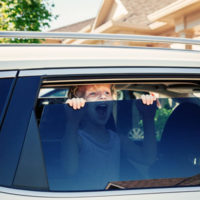Death Toll of Children in Hot Cars is the Highest it’s Been in 20 Years
August 13, 2019 Last year, 52 children died in cars from heatstroke, which is the highest the number has been in over twenty years. According to the National Highway Transportation Safety Administration (NHTSA), there have already been 29 deaths this year.
Last year, 52 children died in cars from heatstroke, which is the highest the number has been in over twenty years. According to the National Highway Transportation Safety Administration (NHTSA), there have already been 29 deaths this year.
Since 1990, our nation has lost nearly 1,000 kids to vehicular heatstroke. Over half the cases resulted from adults forgetting about children in cars, so now is the time to make some changes and help prevent young lives from being lost in these tragic and preventable incidents.
Heatstroke Happens Fast
Even with a window cracked, cars heat up quickly. In just minutes, temperatures can reach as high as 125 degrees. What may come as even more of a surprise is that 80% of the increase in temperature happens in the first 10 minutes after a car is parked. There is no way to prevent this rapid increase from occurring: cracked windows do not stop – or even slow down – the dangerous process.
Cars can get hot even on cooler days. In some cases, children have died from heatstroke in outside temperatures as low as 60 degrees. According to Kids And Cars, a non-profit tasked with guarding children against vehicular heatstroke and other vehicle-associated dangers, heatstroke in cars “is largely misunderstood by the general public.” The biggest mistake parents can make is to believe it “could never happen to them or their family.”
Research: How Heatstroke Happens
National data shows that certain risk factors elevate the chances for children becoming victims of vehicular heatstroke. Jan Null, researcher for NoHeatstroke.org, found that approximately 44% of the time, caregivers meant to or believed they already had dropped a child off at preschool or daycare. The incidents were also far more likely to occur towards the end of the workweek.
Other risk factors for vehicular heatstroke include:
- Children getting into unattended vehicles. This is the second-leading cause for fatal cases of heatstroke in children;
- Body temperature. A child’s body heats up 3-to-5 times faster than an adult’s, and:
- The third-leading cause of fatal heatstroke is leaving a child in a car. It does not matter if the air conditioning is on or the windows are rolled down, a child should NEVER be left alone in a parked car.
Why Caregivers Forget – and What You Can Do
We are all used to going through the motions. Caregivers and parents – especially new parents – are just as prone to entering “autopilot mode” as anyone else. Parents who unknowingly left their children in cars said that they thought they had already dropped them off at daycare or preschool. In some cases, they did not remember their child was still in the vehicle until hours later.
According to memory specialists and researchers when the brain switches to autopilot mode, it stops accounting for changes in routine. The brain goes into autopilot mode when one part of the brain takes over for another. Researchers say this is much more likely to take over when a person is fatigued, so on days that someone is tired it is even more imperative to take precautionary measures.
Safety and Prevention Tips
Kids And Cars recommends the following tips for making sure children are never left unattended – and vulnerable to deadly heatstroke – in vehicles:
- “Look before you lock,” and make a habit of opening the back door every time you park your car and checking the backseat;
- Ask child care providers to call right away if the child does not arrive as scheduled;
- Do not leave keys within reach of children (this will help prevent them from entering parked cars on their own);
- Teach kids to honk if they are in a vehicle alone;
- If you see a child alone in a vehicle, call 911 immediately. If children seem sick or hot, remove them from the vehicle as quickly as possible.
Even car manufacturers realize the unintended danger of leaving a child in a car. As a result, they’re developing new tools to address this risk. Many manufacturers now have door sequencing technology that reminds drivers to check the back seat before exiting the car. If a back door was opened at the beginning of a ride, the car will remind drivers to open it at the end of the ride. There are also sensors to detect if a passenger is in the back of the car once it’s off. If so, drivers will receive text messages and horns and lights will sound.
Philadelphia Personal Injury Lawyers at Galfand Berger, LLP Representing Injured Individuals Since 1947
If you have questions about vehicular heatstroke, please contact our Philadelphia personal injury attorneys. With offices located in Philadelphia, Bethlehem, Lancaster, and Reading, Galfand Berger serves clients throughout Pennsylvania and New Jersey. To schedule a consultation, call us at 800-222-8792 or complete our online contact form.
 Google Screened
Google Screened
